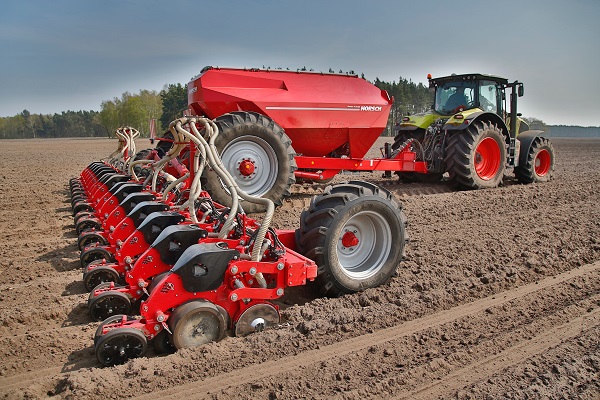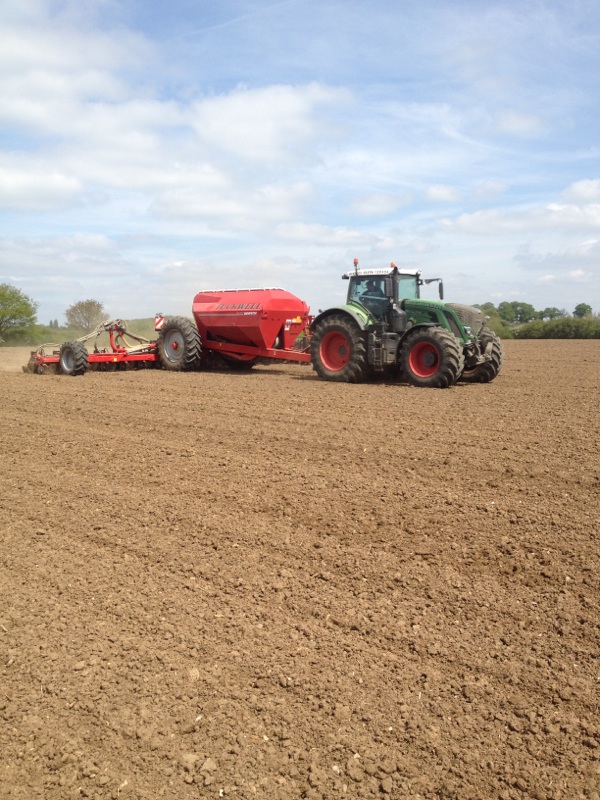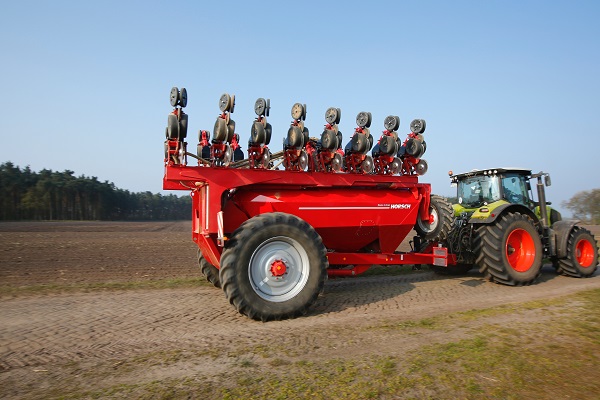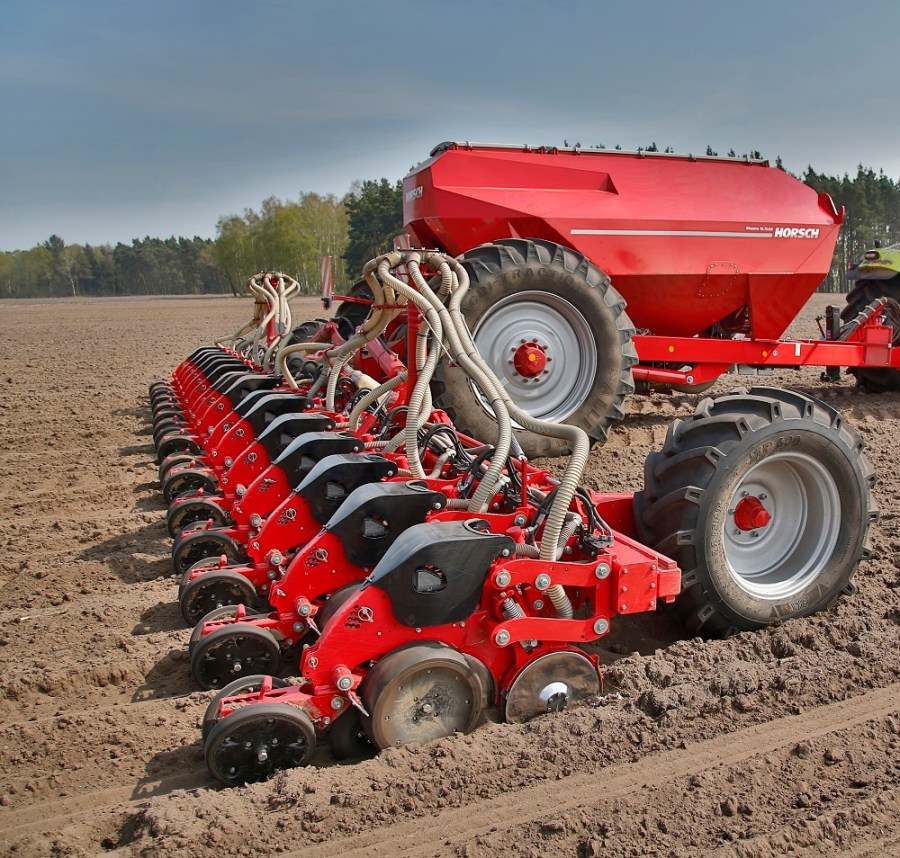Horsch’s new AutoForce coulter control system was offered for evaluation to a Bucks-based contractor when he purchased a new 12m Maestro 16SW maize drill last year. CPM visits to find out how he got on.
It’s the best drill for seed placement I’ve ever used.
By Jane Brooks
Bucks-based farmer and contractor Daniel Tuckwell, who runs the business alongside his father Robert was in the unique position of being the first UK user of Horsch’s protptype AutoForce system, when it was fitted to the new 12m Maestro 16SW drill he purchased last year.
“Our farming enterprise grows 1300ha of maize, some is contract farmed and the rest is on our own farms. We grow 730ha ourselves to supply a local AD plant. We own 31ha here and farm 1335ha of rented ground on farm business tenancies. The remainder of the rented ground is in wheat, barley and forage rye. Some is also down to grass as we have a Belgian Blue single-sucker herd,” explains Daniel Tuckwell.

The Maestro covers around 4ha/hr and can be pulled with a 240hp Fendt 724, but on more hilly country they upgraded to a more powerful Fendt 936
Some of the fields on the contract farming side have been mapped, although new blocks of land are routinely soil-tested with the agronomist so they know what they’re dealing with.
With other agricultural contacting work, the Tuckwells foraged a total of 3800ha of grass, wholecrop and maize last year. “Predominantly we’re mainstream agricultural contractors aimed at the dairy sector. So we’re running balers, muck spreaders as well as the machinery on the arable contracting side where we offer cultivation, spraying and harvesting services. We also do some non-agricultural work, such as fencing. What’s more, we have grab and sweeper lorries as well as 360° diggers, just mixing it up in the off-peak period.”

The drill itself has a 75mm fixed planting space, it’s used to plant maize by the Tuckwells, although it has the capability to use different seed wheels to drill other single seed crops.
Although happily running a Kverneland drill for a few years, the business had reached the point where more output was needed. The idea of running two drills was discussed but it was decided that a bigger drill would be better suited to their contracting needs.
Arable manager and main drill operator Scott Hosking takes up the story. “We had a Väderstad maize drill and a Horsch on demonstration. I personally liked the Horsch, there was nothing wrong with the Kverneland, but at the size we needed they could only offer a mounted model. We feel a trailed drill is better suited to our heavy ground and Horsch could provide the trailed 12m Maestro 16SW which was the size we wanted.

It’s a big drill, but for road transport it folds to 3m when it’s all shut up.
They were offered AutoForce with the drill, and were actually the first in the UK to have the system. “We were asked to trial it for Horsch, although I have to admit initially I was a sceptical about any benefits it might bring to the job,” he comments.
AutoForce adjusts coulter pressure according to the different soil types, explains Scott Hosking. “What the Horsch does is when it gets down to the lighter soil it senses that it isn’t taking so much resistance on the seeder unit, so it lets the pressure off to maintain the seeding depth. It’s a physical sensor so it needs a physical trigger to make it move and this is based on force. So when you start going back into the heavy soil again, it starts increasing the coulter pressure.
“With fine light soil, you don’t need a lot of coulter pressure to get the seed in the ground, whereas with heavier soil you need a lot of pressure. Because not every field is straight clay or sand from top to bottom, AutoForce constantly reads the pressure and balances it out so you keep coulter pressure right to get optimum seeding depths all across the field.
“The old drill was a fixed spring so you’d wind it on in the heavier soil and when you drove down the field down into slightly lighter soil you had a tendency to put it in a bit deeper as you still had more coulter pressure.”
Daniel Tuckwell says the Maestro covers around 4ha/hr and they’ve drilled over 1300ha with it so far. Initially it was on a 240hp Fendt 724, which was OK, but on more hilly country they upgraded to a more powerful Fendt 936, which they find has better oil flow.
“The drill is travelled empty to clients. Generally we work within a 22-mile radius of the farm. Customers often provide their own seed and the central filling hopper is a distinct step-up from the pods on the old machine,” says Scott Hosking explains.
“It’s easier for the customers – they meet me in the morning, we fill the drill up and that’s it, they don’t have to worry. They make their own decisions on fertiliser as well. We made sure the drill has both fertiliser and micro-granular capabilities.”
Individual shut-off for fertiliser and seed ensures there’s no overdose of either. The seed wagon is split, with a capacity of 2000 litres for seed and 7000 litres for fertiliser. “You can run on a fertiliser and a seeding map if you wanted to, but it’s not something we’re doing at the moment,” he adds.
“One thing that people have commented on is the evenness of the crops. Whereas before you would have some parts of the field where plants struggle to come through, the crop all emerges evenly and you can see it all the way through the growing season.”
There were a few initial hiccups with the fertiliser sensors, mainly on the big bag side, but these were quickly sorted out. “When we first got the drill, Tom Mould from Horsch came out to set it up with us. It was a new product for him as well, but if we had a problem he’d talk to Horsch in Germany and get back to us with a solution.
“Initially we found the AutoForce coulter pressure changes weren’t quite fast enough in small fields. In Germany you have much larger fields and it has enough time to react. So Tom came out, we made some alterations to the settings and it transformed how we were drilling.
“Actually Tom is coming out to go through it with me for the start of this season as there are some updates and more fine tuning of the Autoforce settings to be done. We’ve been using it on the medium setting, but there are two pressure ranges and a low, medium and hard setting for different soil groups that we’ll be adjusting.”
The drill itself has a 75mm fixed planting space and is only used for maize, although it does have the capability to use different seed wheels to drill other single-seed crops.
“The fixed spacing suits us,” says Daniel Tuckwell. “I like the drill purely because of its size – it covers a lot of ground and we’re 50/50 AD and forage maize. Our customers are overwhelmingly happy with establishment and the evenness of the crop is very noticeable.
“It’s a big drill and people were concerned when it turned up, as we’ve gone from 6m to 12m, particularly when we unfolded it in a field. But it folds to 3m when it’s all shut up. In the field, it’s travelling on big wheels, so you’re putting less wheelings down because you’re wider and we aren’t adding compaction. Also, depending on variety and seed weight, we can get 50ha of drilling in one fill of the seed hopper on the drill.”
Daniel Tuckwell keeps a soil temperature thermometer in his truck and in early April he starts driving around checking fields. “We aim for a soil temperature of 8°C especially in this heavy soil as there’s no point drilling early. We’re also working for arable farmers that have a blackgrass problem.
“With the chemicals we have at our disposal for maize we’re managing blackgrass quite well. But as to the best way forward, that’s the unanswerable question – ploughing is part of what we offer, but I think there’s a place for minimum cultivation, too.”
Preventing soil slump is one of the biggest problems he faces on heavy land, and they’re trying forage rye before the maize to address it. “We did a trial with an arable farmer last year and he made profit on his rye and his following spring barley – it wasn’t a lot, but it equated over the area to a decent return.
“Predominantly though, we plough, if spring conditions are right and then sub soil unless it’s too wet. The sub-soiler does two things for us firstly we’re sub soiling to make better roots and secondly we hope we get away from compaction and water-logged areas. We then go in with the power harrows.”
A pre-emergence spray takes care of weeds, provided there’s enough soil moisture. “We’ve just purchased an Amazone Panterra Sprayer – pound for pound I think we have the most amount of technology you can currently buy that won’t be outdated in five to seven years’ time.”
The Tuckwells run a comprehensive machinery fleet – Lister Wilders’ Wallingford branch supply their Fendt tractors and Olivers at Tingewick supply the Claas as well, being the local Horsch agents. Tractors are changed at 6000 hours as they’re purchased with a 6000hr warranty. The Fendts run Topcon x30 through mobile phone RTK, which Scott Hosking says works well in the area they cover. The drill runs through the x30 screen or its own screen.
So is Scott Hosking happy with the choice of drill and its AutoForce? “I would have it on the maize drill, the corn drill, anything it would go on just for that seed placement – it’s the best drill for seed placement I’ve ever used. I was a bit wary about how well AutoForce would work and how it would react but since using it, well, it’s absolutely fantastic.”
AutoForce comes in across Horsch Maestro range
AutoForce is a system that automatically adjusts coulter pressure on the move to varying soil conditions. On the Maestro drill, there are one, two or four independent sections over the working width of the machine. The 16-row machine is divided into two sections of eight coulters each, for example.
The pressure is measured by two sensors, which are mounted on both support wheels. The system controls the pressure of the cylinders at the parallelogram, and also keeps the weight constant on the support wheels.
However, separate hydraulic arms provide down pressure to each section, allowing the dedicated software to adjust each section. This means the system can alter coulter pressure to maintain the same seed-depth placement.
When the operator sets the seed depth, during planting, automatic seed-bar adjustments to maintain this depth are made as the machine operates. This is possible because the design of the Maestro Drill allows weight to be transferred just to the seed bar.
This allows on-the-move variations in coulter pressure of 125-300kg. Less pressure can therefore be applied to the coulter section in soft ground but quickly corrected if ground conditions merit a change in pressure, meaning the coulters maintain an accurate seed-depth placement at higher speeds.
Horsch says that AutoForce offers greater control that their standard system that provides uniform pressure across all rows. The system can also be specified across one section for smaller machines.
Farm Facts
Robert Tuckwell Agricultural Contracting Services
Salden Crabtree Farm, Little Horwood. Milton Keynes, Bucks
- Farmed Area: 1335ha on a Farm Business Tenancy; 4000ha+ contracting
- Cropping: 730ha maize, 40ha barley, 57ha forage rye; 3800ha forage crops, grass, wholecrop and maize
- Agronomist: Phil Styles, Hutchinsons
- Soil: Predominantly heavy clay
- Main line tractors: 5x Fendt 936, Fendt 724, 2x Claas 640, 7x Claas 650
- Telehandler: 2x pivot-steer JCB 320, pivot-steer JCB 310
- Combine: Claas Lexion 600 with 10.6m header
- Loader: Cat TH63 12m, JCB 535, JCB 434S Loading shovel
- Drills: 12m Horsch Maestro 16SW, 6m Väderstad Rapid, 4m Horsch CO4, 4m KRM combination
- Cultivation: 3m Sumo Trio, 2x Lemkin 6f ploughs, 5-leg Simba Flatliner, Väderstad Carrier, Simba Cultipress, 6m Kuhn power harrow, 6m Amazone power harrow, 5m Amazone power harrow, 4m Kuhn power harrow
- Sprayer: Amazone Panterra 4502 with 36m boom
- Spreader: Amazone ZAM Profis
- Staff: Robert and Daniel Tuckwell plus 15 full time, 12 seasonal workers




